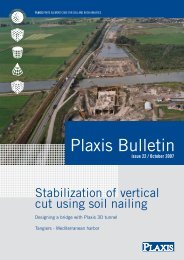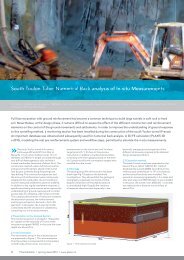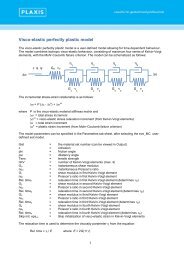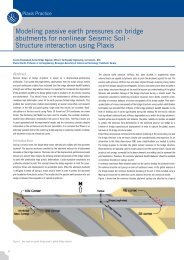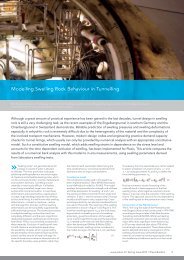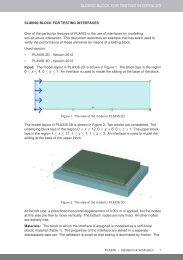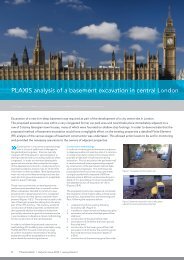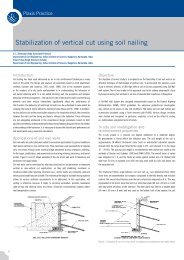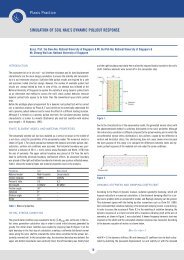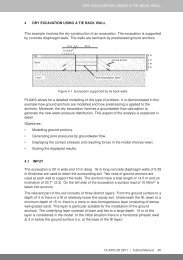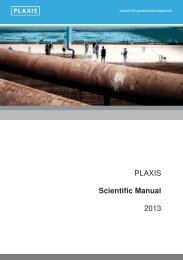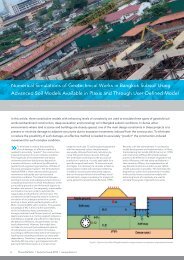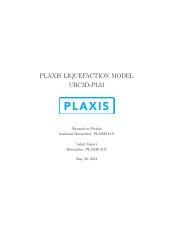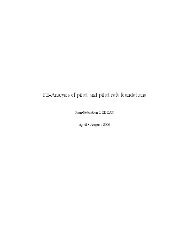Waterman, D., Broere, W., 2004, Application of the SSC model - Plaxis
Waterman, D., Broere, W., 2004, Application of the SSC model - Plaxis
Waterman, D., Broere, W., 2004, Application of the SSC model - Plaxis
You also want an ePaper? Increase the reach of your titles
YUMPU automatically turns print PDFs into web optimized ePapers that Google loves.
The second possibility to assign a correct OCR value in <strong>Plaxis</strong> is to leave <strong>the</strong> OCR equal<br />
to 1 in <strong>the</strong> initial conditions and start <strong>the</strong> calculation with a plastic nil step. For this<br />
phase set <strong>the</strong> time interval equal to ∆t. <strong>Plaxis</strong> will now calculate <strong>the</strong> stress state due<br />
<strong>the</strong> creep over that period, which results in a certain OCR. In <strong>the</strong> second phase <strong>of</strong> <strong>the</strong><br />
calculation <strong>the</strong> settlements due to <strong>the</strong> simulation <strong>of</strong> <strong>the</strong> creep history must be discarded<br />
using <strong>the</strong> “reset displacements to zero” option in <strong>Plaxis</strong> Calculations.<br />
Generally, if ∆t is large <strong>the</strong> exact value becomes less important, as <strong>the</strong> OCR depends<br />
on natural logarithm <strong>of</strong> time. It makes a large difference whe<strong>the</strong>r soil has been in place<br />
for 10 days or 1 year, but <strong>the</strong>re will be relatively little additional creep between 100<br />
years or 200 years.<br />
When generating <strong>the</strong> initial stresses using <strong>the</strong> K 0 -procedure, <strong>the</strong> influence <strong>of</strong> <strong>the</strong> OCR<br />
warrants some extra attention. The initial vertical preconsolidation stress at a certain<br />
depth is calculated, as might be expected, from <strong>the</strong> effective weight <strong>of</strong> <strong>the</strong> soil on top<br />
multiplied by <strong>the</strong> OCR value that has been entered (σ c = OCR . σ' y ). When a plot <strong>of</strong> <strong>the</strong><br />
OCR values obtained in this way is inspected, it can be noticed that <strong>the</strong> reported OCR<br />
values differ slightly from <strong>the</strong> enter value. The reason for this is that <strong>the</strong> OCR value<br />
<strong>Plaxis</strong> Output reports is calculated using <strong>the</strong> stress measure p eq , defined as<br />
This stress measure is used internally by <strong>Plaxis</strong> to define OCR from p p = OCR . p eq . The<br />
reason for this is that <strong>the</strong> regular definition <strong>of</strong> OCR (σ c = OCR . σ' y ) is not always<br />
meaningful in complex 3D loading situations. And although it would be preferable to<br />
report OCRs using <strong>the</strong> same definition as used in <strong>the</strong> initial conditions, unfortunately it<br />
is not possible to derive Cartesian stresses from p eq in case <strong>the</strong> cohesion is nonzero.<br />
In order to illustrate this a simple example is given. Define in <strong>Plaxis</strong> V8 a square <strong>of</strong> 1x1m<br />
with standard boundary conditions and a distributed load on top.<br />
Define a material data set using <strong>the</strong> S<strong>of</strong>t Soil Creep <strong>model</strong> and <strong>the</strong> material type set to<br />
drained. O<strong>the</strong>r material parameters are given in table 1. Normally one would use<br />
undrained material behaviour but to more clearly illustrate creep only drained behaviour<br />
is selected here.<br />
Parameter Name Value Unit<br />
Material <strong>model</strong> Model S<strong>of</strong>t Soil Creep -<br />
Type <strong>of</strong> material behaviour Type Drained -<br />
Unit weight <strong>of</strong> soil above phreatic level γ unsat 17.0 kN/m 3<br />
Unit weight <strong>of</strong> soil below phreatic level γ sat 17.0 kN/m 3<br />
Modified compression modulus λ* 0.025 -<br />
Modified swelling modulus κ* 0.010 -<br />
Modified creep modulus µ* 0.001 -<br />
Cohesion (constant) c ref 1.0 kN/m 2<br />
Friction angle φ 28.0 º<br />
Dilatancy angle ψ 0.0 º<br />
Table 1: Material parameters<br />
For this case <strong>the</strong> sample is assumed dry and for initial stresses generation <strong>the</strong> default<br />
values for K 0 and OCR are used. The calculation consists <strong>of</strong> 5 phases:<br />
1. A load <strong>of</strong> -100 kPa is applied at <strong>the</strong> top with time interval zero.<br />
2. A staged construction phase with a time interval <strong>of</strong> 100 days. Use <strong>the</strong> “reset displacements<br />
to zero” option.<br />
3. Starting from <strong>the</strong> initial phase once more add a staged construction phase with a<br />
time interval <strong>of</strong> 36500 days (100 years).<br />
4. A load <strong>of</strong> -100 kPa is applied at <strong>the</strong> top with time interval zero.<br />
5. A staged construction phase with a time interval <strong>of</strong> 100 days. Use <strong>the</strong> “reset displacements<br />
to zero” option.<br />
Start <strong>the</strong> calculation and ignore <strong>the</strong> warning about calculation phases with zero time<br />
interval.<br />
Figure 2 shows a graph <strong>of</strong> <strong>the</strong> displacements vs. time for a node in <strong>the</strong> sample. The<br />
additional resting time <strong>of</strong> phase 3 increased <strong>the</strong> OCR from 1 to approximately 2.4<br />
resulting in a stiffer behaviour <strong>of</strong> <strong>the</strong> sample as can be seen from <strong>the</strong> figure.<br />
0,000<br />
-0,005<br />
Uy (m)<br />
-0,010<br />
-0,015<br />
-0,020<br />
-0,025<br />
-0,030<br />
-0,035<br />
loading after 100 years<br />
-0,040<br />
-0,045<br />
immediate loading<br />
-0,050<br />
0 20 40 60 80 100 120<br />
Time (days)<br />
Figure 1: Geometry used in this example.<br />
Figure 2: Time - settlement curve.<br />
15



